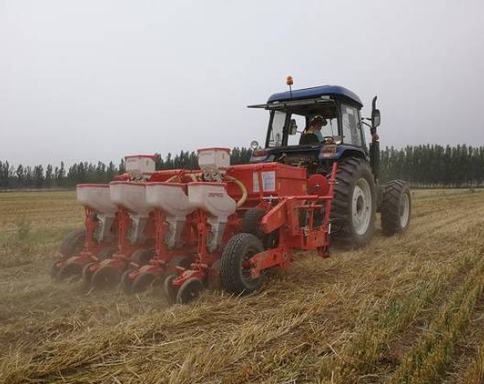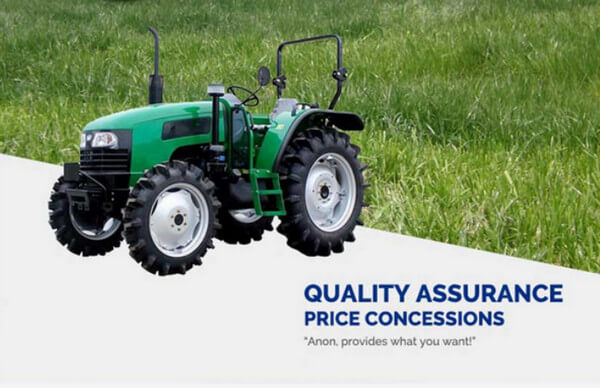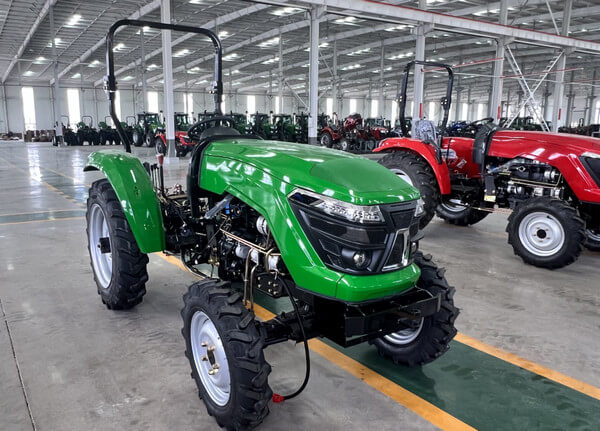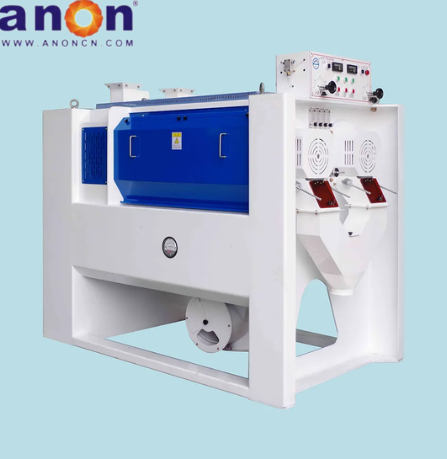Introduction
In modern agriculture, various agriculture machines are now used in the fields, greatly improving farming efficiency. One of these machines is the air seeder, which can help you efficiently complete large-scale planting. In the following article, I’ll introduce you to it, and I hope you find the information helpful.
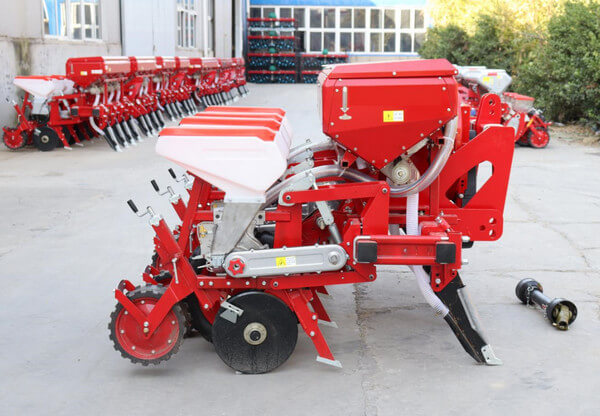
What is an air seeder?
An air seeder is a type of agricultural machine commonly used for precise planting. Unlike traditional machines that rely on mechanical parts to plant seeds into the soil, an air seeder uses airflow to evenly distribute seeds from the seed box to the exact spots in the soil. It’s ideal for large-scale planting.
An air seeder needs to be used with a tractor and comes in two types: towed and mounted. The towed air seeder requires less tractor horsepower. You can choose the type based on the horsepower of your tractor.
How Does an Air Seeder Work?
Air seeders can be divided into two types based on the working principle: air-suction seeders and air-blowing seeders.
Air Suction Seeder
In an air suction seeder, a high-speed fan creates a negative pressure, which is transferred to the vacuum chamber of the seed dispensing unit. As the seed disc rotates, seeds are drawn into the vacuum chamber due to the negative pressure. The seeds stuck to the disc also rotate with it. When the disc exits the vacuum chamber, the negative pressure is gone, and the seeds either fall by gravity or are scraped off by a seed scraper and drop into the soil.
The seed disc can be changed according to the seed size, allowing it to handle seeds from various crops.
Air Blowing Seeder
The air-blowing seeder works differently. It has a compressed air system inside. This system uses a compressor to compress air to a certain pressure, creating high-speed airflow. When seeds in the seed box fall through a flow control mechanism, the high-pressure air blows the seeds through a hose and into the soil. Even if the seeds are light, the air-blowing seeder can perform the task effectively.
Benefits of Air Seeder
Increased Planting Efficiency
The air seeder is equipped with a furrow opener and press wheels, which help plant seeds at a certain depth. You can also choose the number of rows based on your needs. If you have a large area of land, you can select more rows, which can significantly reduce your labor, resources, and time costs.
Precision and Uniformity
Whether it’s an air-suction seeder or an air-blowing seeder, both can achieve precise planting with the help of furrow openers and seed guides. This ensures that seeds are evenly distributed in the field, with accurate planting rates, uniform spacing, and consistent planting depth. This eliminates errors from manual seeding and creates the best conditions for seed growth and development.
Versatility in Crop and Soil Types
Each unit of the air seeder uses a four-bar linkage mechanism with welded pipe parts. Bearings are used at the joints for smooth rotation. The whole unit can move up and down with the terrain, improving contouring. This means that even if the land is uneven, it can maintain a consistent planting depth.
The furrow opener can adapt to various types of land. By changing the seed dispensers, it can be adjusted for different crops, making it quite versatile.
Improved Crop Yields
The air seeder’s planting method is gentle, causing minimal damage to the seeds and ensuring their integrity. It also provides proper spacing and planting depth for the seeds, giving them adequate space to grow and reducing the risk of lodging. This effectively improves seed germination rates and crop yields.
Environmental Sustainability
The air seeder’s precise planting reduces seed waste and improves seed efficiency. The proper spacing between seeds makes it easier to manage the crops, so you don’t need to use as many pesticides and herbicides.
The seeder works with minimal soil disturbance, protecting soil structure and fertility. This is beneficial for long-term farming.
Main Components of Air Seeder

Seeder Box
The seed box, as an important part of the seeder, is made of stainless steel with a larger size to increase seed capacity and reduce the need for refilling. The pointed bottom design ensures that no seeds are left over during operation, preventing waste.
Seed Metering
The seed dispensers in air suction and air-blowing seeders are different.
The seed dispenser is usually a disk with evenly spaced small holes in an air suction seeder. The vacuum system holds the seeds and carries them to the planting position. By changing the disk, you can plant different crops.
In an air-blowing seeder, the seed dispenser is a shaft with grooves. It rotates to evenly carry seeds from the seed box.
Vacuum System/Air Pressure System
Besides the difference in seed dispensers, the core seeding structures of air suction and air-blowing seeders are also different. An air suction seeder uses a vacuum system that works with negative pressure, while an air-blowing seeder uses an air compression system that operates with positive pressure.
Seed Delivery Tubes
Because of its working principle, the air-blowing seeder also comes with a seed delivery tube. This tube ensures that the airflow directs the seeds to the exact location, improving both seeding speed and accuracy.
Opener
The main function of the furrow opener is to create a seed trench at a certain depth, guiding the seeds into the soil. To ensure good seed germination and crop resistance to lodging, you need to adjust the furrow depth based on soil type, moisture, and seed type.
Drive Wheels
The purpose of the drive wheels is to move the air seeder forward. Their design affects the stability and speed of the seeder. The stable movement ensures that seeds are evenly planted.
Press Wheels
The press wheels compact the soil after the seeds are planted, covering them effectively. This ensures close contact between the seeds and the soil, reduces large air pockets, and helps maintain soil temperature and moisture, which improves seed germination and growth speed.
Operating Instructions for Air Seeder
Inspect the Equipment
Before using the seeder, check if there is any debris in the seed box and if the furrow opener has any weeds or clay. Make sure all parts are in good condition and add lubricating oil to the moving parts according to the manual.
After connecting the seeder to the tractor, make sure the seeder stays level. Also, adjust the seeding rate, row spacing of the furrow opener, and the depth of the furrow and cover according to your needs. Ensure the seeds added to the seed box are clean and free of debris.
During Operation
To ensure good seeding quality, you should do a test run before planting a large area. Usually, the test is 10 to 20 meters and proceeds only after confirming it meets the requirements.
While working, drive slowly to avoid affecting the seeding quality. Also, avoid moving forward or backward when the machine is stopped to prevent overlapping or missed planting. Make sure to add seeds in time, and keep the seed box at least one-quarter full.
Post-Operation Procedures
After seeding, clean out any leftover seeds from the seed box, wipe off dirt and grime from the seeder, and add lubricating oil to the needed parts.
Maintenance of the Air Seeder
To ensure long-term, efficient, and accurate performance of a pneumatic seeder, regular maintenance and proper calibration are essential.
Lubrication and Maintenance
Before operating the seeder, make sure to lubricate all designated points to ensure smooth functioning of the moving parts. Avoid applying oil directly to gears and chains, as this can attract dirt and increase wear. When the fan operates at high input speeds, the fan pulley bearings must be oiled periodically to prevent bearing failure due to a lack of lubrication.
Regular Cleaning
After each use, you need to thoroughly clean all parts of the machine. Pay special attention to removing dirt and grease from the transmission system. Check whether the seed and fertilizer shafts rotate smoothly. Clear any remaining fertilizer from the hopper promptly to avoid corrosion of the fertilizer box and distribution components.
Regularly inspect the seed hopper and delivery components of the seeder. Gently tap or brush off any buildup to maintain stable and efficient operation. Periodically adjust seeder settings—such as seeding depth, row spacing, and plant spacing—to ensure seeds are placed at the correct density, depth, and intervals.
If any mechanical parts, such as openers or covering devices, are worn or damaged, replace them promptly to avoid affecting seeding quality.
Storage and Transportation
You should store the seeder in a dry, well-ventilated shed or warehouse to avoid damage from outdoor exposure. When storing, ensure the frame is securely supported. Openers and covering devices should be propped up with boards to prevent direct contact with the ground.
Rubber or plastic components such as seed and fertilizer delivery tubes should be removed, cleaned, and bundled neatly. Store them in a box or on a rack to avoid crushing, bending, or deformation. The pressure springs on the openers should be released to remain in a relaxed, free state.
Tips for Choosing the Right Air Seeder
Farm Size and Terrain
First, consider your farm’s size and terrain. For large farms, it’s recommended to choose a seeder with a wide working width and large seed/fertilizer hoppers to reduce the frequency of refilling and improve operational efficiency.
For hilly or irregular terrain, opt for models equipped with high-quality floating tires and independently controlled systems. These features help the machine adapt to complex ground conditions and maintain uniform seeding.
Choosing a seeder that can flexibly match your field type is key to achieving efficient and consistent performance.
Seeding Rate Requirements
Different crops and soil conditions require different seeding rates. Therefore, it’s crucial to choose a seeder that allows easy and precise adjustment of the seeding rate. This flexibility enables quick adaptation to various crops and ensures optimal planting density.
Compatibility with Tractors and Implements
Before purchasing, make sure the seeder is fully compatible with your existing agricultural equipment. Check that your tractor has enough horsepower to handle the seeder, especially for larger models or those with dual-function (seed and fertilizer) systems.
Also, confirm that the seeder’s hydraulic system and electronic control terminal are compatible with your tractor to avoid operational issues or control failures.
Future Trends in Air Seeder
As technology advances, the performance of air seeders will continue to improve. In addition to current seed detection devices, future designs may include sensors to detect soil type and moisture levels, allowing for automatic adjustment of furrow depth.
The seed disc can also be adjusted in size based on the type of crop, so manual changes are no longer needed.
Wrap Up
I have shared a lot of information about air seeders that you can use when buying and operating one. If you are considering purchasing a seeder now, feel free to consult us at ANON. We believe our professional service and high-quality machines will satisfy you.
FAQ
What can you plant with an air seeder?
Air seeders are very suitable for planting small seeds. Because of their size, small seeds require precise handling to achieve good seeding results. By simply changing the seed disc, you can plant over thirty types of crops, including wheat, canola, rice, soybeans, corn, sorghum, some vegetables, and some herbs.
What is the difference between an air seeder and an air drill?
An air drill is a modified version of an air seeder. The main difference is that an air drill does not have wheels within its frame that carry the opener hardware. Support and depth control for the machine is provided by a specialized compacting wheel at the rear of the drill.
What are the disadvantages of air seeders?
The disadvantage of air seeders is that they are not suitable for all types of seeds. They do not work well with larger seeds and are better with small, round seeds, so you need to consider what you want to grow before buying one. Some air seeders also have issues with seeds clogging the seeding line.


